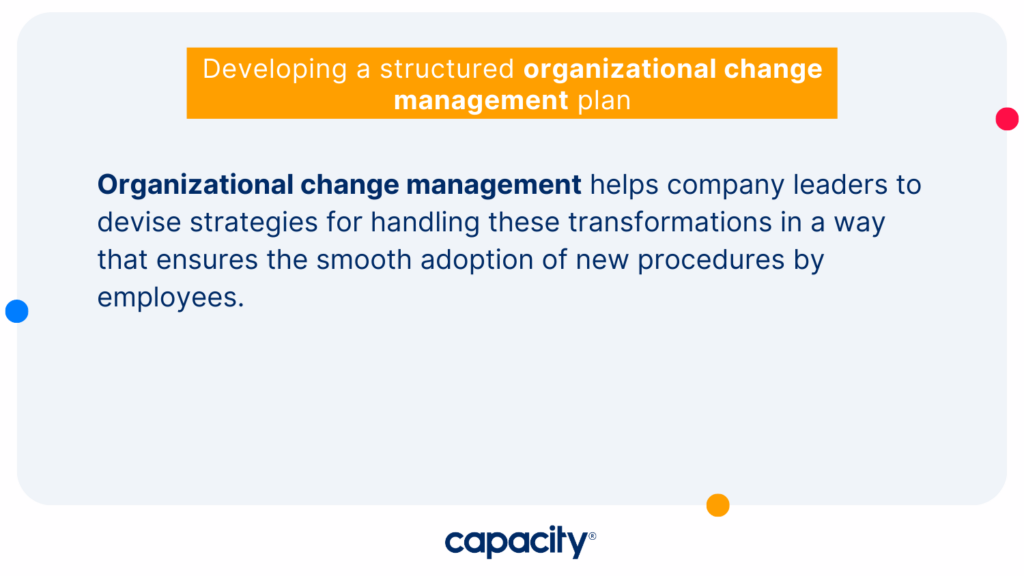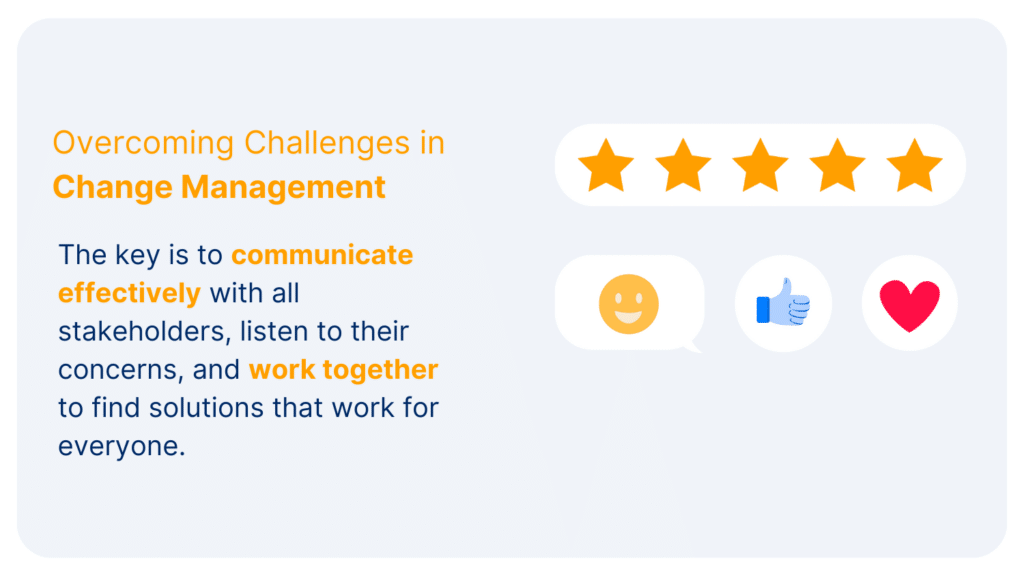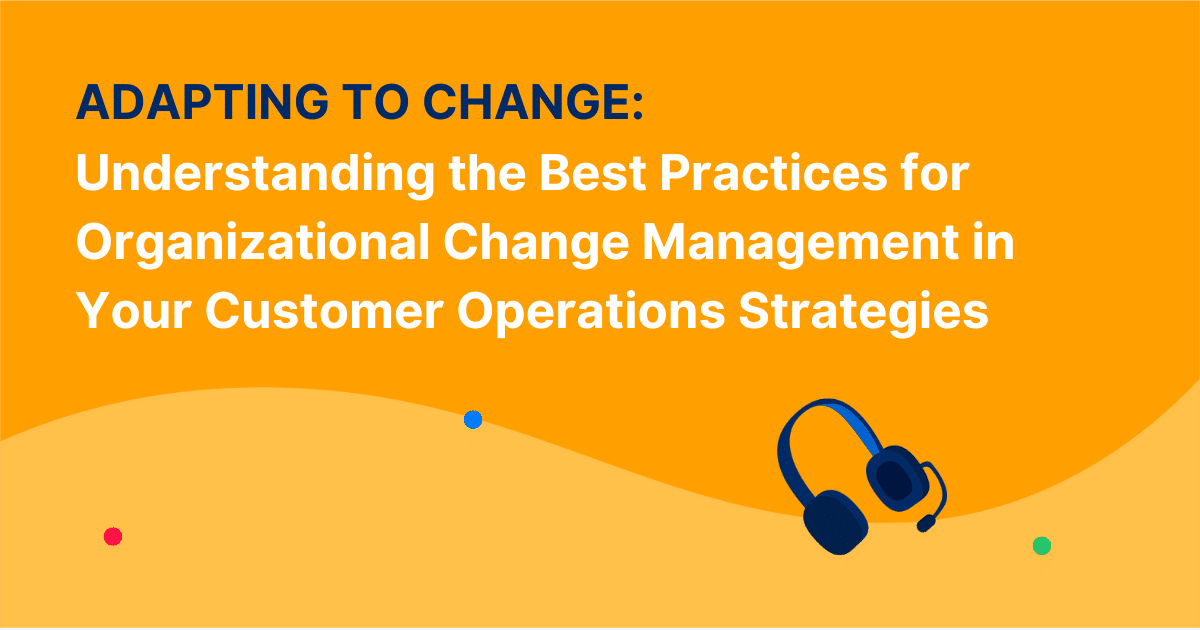The customer service landscape is changing. With increased demands from customers, organizations have begun to explore new approaches and technology impelled by Artificial Intelligence (AI) and automation tools in order to remain competitive. To ensure the successful adoption of such practices, robust organizational change management needs to be put into place – otherwise, enterprise-wide transformation initiatives can quickly go awry.
In this blog post, we’ll dive into best practices for understanding how organizational change management should be handled when implementing AI and automation tools within a customer service department setting. We’ll analyze key considerations when making changes to operations, potential pitfalls that need to be avoided while executing any kind of change processes throughout an organization; as well as outline some useful communication strategies designed specifically for IT, Contact Center Managers and Customer Operations personnel so that everyone involved has the necessary knowledge base needed in order for these initiatives take flight without issue or delay.
Understanding Organizational Change Management
Change is inevitable, especially in the fast-paced world we live in. As organizations evolve, they often encounter challenges requiring a significant shift in their operations and processes. This is where organizational change management comes in. A structured approach to transitioning teams, individuals, and business units from their current state to a desired future state, it’s critical for the success of any transformation.
Advancements in technology play a pivotal role in driving change forward. The integration of Artificial Intelligence (AI) and Automation tools is no exception. The benefits of this powerful combination are plenty, including streamlining workflows, lowering operational costs, increasing productivity, and enhancing accuracy and speed. In addition, these technologies can help organizations adapt to the changing needs of the business world while mitigating risks.
Effective management of change is not an easy task. It requires a combination of the right leadership, communication, and technical expertise. However, when done properly, it can lead to significant benefits for both the employees and the organization as a whole. As companies continue to explore and integrate innovative technologies like AI and automation tools, they must be prepared for the challenges and opportunities that come with change.
What is Organizational Change Management?

It is the process of guiding an organization through a period of change, whether it be a shift in structure, technology, or culture. Essentially, organizational change management is about preparing your team for change to ensure a smooth transition with little to no disruption to the business. Implementing new processes and initiatives can be a daunting task, but with the right approach, it can be a beneficial experience that drives growth and innovation. When done correctly, organizational change management can lead to a stronger, more efficient, and more resilient company.
Best Practices for Adapting to Change in Customer Operations
Organizational change management is crucial in adapting to change, especially in customer operations where demands can shift at a moment’s notice. It’s important to be proactive in anticipating what changes may come and how to prepare for them. Having a solid plan in place can make a world of difference in navigating through the shifts in customer needs. But more than having a plan, the key is having a team that is open and flexible to change. Communication is also key in ensuring everyone is on the same page and that everyone understands the reasons behind the changes. While change may seem daunting, it can also bring new opportunities. By embracing change and being prepared for it, companies can stay ahead of the curve and deliver better service to their customers.

Clear and Transparent Communication: Establishing open channels of communication
Effective communication is crucial for organizational change management. In today’s fast-paced world, it is essential to establish open channels of communication in every organization to ensure transparency and clarity. However, it’s not enough to simply communicate often. It’s important to make sure that everyone understands the message being communicated. Language barriers, technical jargon, and unclear phrasing could all hinder effective organizational communication. To overcome these challenges, organizations must promote clear and transparent communication throughout all levels of the company, encouraging employees to ask questions and give feedback. This will help everyone feel involved and informed which will lead to a smoother organizational change management process.
Leadership and Employee Engagement: Creating a culture of involvement and empowerment
Leadership is not just about telling people what to do. It’s about creating an environment where employees can thrive and be empowered. This is where organizational change management comes in, as leaders need to understand how to create a culture of involvement and engagement. When employees feel valued and heard, they are more likely to stay committed to the company and its goals. Effective leadership also involves trust and transparency, where leaders communicate openly about their vision and strategy for the organization. By prioritizing employee engagement, organizations can build better teams that work together towards a common purpose and drive success. It’s time to start prioritizing creating a culture of involvement and empowerment to take your team to the next level.
Planning and Preparation: Developing a structured organizational change management plan

When it comes to initiating change within an organization, having a well-structured plan is vital. Any new system or process will affect the way things are done, and that’s why proper preparation is necessary to prevent resistance and confusion. Organizational change management helps company leaders to devise strategies for handling these transformations in a way that ensures the smooth adoption of new procedures by employees. The process often involves setting specific goals, identifying potential challenges, determining suitable time frames, and outlining processes for communication and training. By doing so, the changes that are introduced will be less disruptive and more likely to achieve intended outcomes, leading to greater success for the organization as a whole.
Training and Skill Development: Equipping employees with the necessary skills and knowledge
In today’s fast-paced business world, staying ahead of the game is essential for organizational success. Training and skill development programs are a crucial component of equipping employees with the knowledge and abilities they need to thrive. Effective organizational change management is key in implementing these programs, ensuring they are integrated seamlessly into the company culture. By investing in employee skill development, organizations can boost productivity, morale, and ultimately, their bottom line. Through continuous learning and upskilling, employees are better equipped to meet new challenges and handle changing industry landscapes with confidence.
Managing Resistance: Identifying and addressing resistance to change
One of the biggest hurdles that companies face when implementing change is managing resistance. Identifying the reasons for resistance and effectively addressing them can make all the difference in the success of the change initiative. Whether it’s fear of the unknown, lack of trust in leadership, or simply the discomfort of breaking from routine, resistance to change is a natural human response. Smart leaders understand this and proactively engage employees in the process, communicate transparently, and provide adequate training and resources. With careful planning and thoughtful execution, managing resistance can become a key factor in driving positive change within an organization.
Monitoring and Evaluation: Continuously assessing and adjusting change initiatives
As organizations grow and evolve, they often seek to implement change initiatives to better serve their goals and objectives. However, successfully managing change is no simple task-it requires ongoing monitoring and evaluation to ensure that the initiative is achieving its intended results. This is where organizational change management comes into play. By continuously assessing and adjusting these initiatives, organizations can ensure they are on track to reach their goals. Whether it’s restructuring teams, implementing new technologies, or shifting company culture, monitoring and evaluation are crucial to ensuring that change initiatives are successful. By making adjustments as needed, organizations can not only adapt to the ever-changing business environment but also stay ahead of the competition.
Aligning Change Management with Customer Operations Strategies
In today’s fast-paced business environment, companies constantly strive to meet the ever-changing needs of their customers. This means that change management within the organization is inevitable. However, it is crucial that organizational change management is aligned with customer operations strategies to ensure a seamless transition and a better customer experience. By doing so, companies can create a customer-centric culture and establish a strong relationship with their customers. Effective change management can not only improve customer satisfaction but also boost employee engagement and productivity. Therefore, it’s essential for companies to develop a well-defined change management plan that is in sync with their customer operations strategies.
Overcoming Challenges in Change Management for Customer Operations

Change management is a crucial process for any organization that wants to stay ahead of the curve, but it can be a tough pill to swallow for some employees. Resistance to change is common, and it can present a significant challenge when it comes to customer operations. Identifying these obstacles is the first step toward success, which is why organizational change management is critical. With the right strategies in place, the resistance can be overcome, and setbacks can be addressed. The key is to communicate effectively with all stakeholders, listen to their concerns, and work together to find solutions that work for everyone. By doing so, organizations can unlock the benefits of change management and take their customer operations to the next level.
Overall, organizational change management is a critical piece of the puzzle when introducing AI and automation tools for customer service operations. Though it may seem overwhelming at first, taking the time to implement best practices can make all the difference in successful deployments and operational success. As organizations embrace new technology and begin to build customer service teams composed of both humans and machines, effective change management will play a prominent role in these transition processes.
With proper planning, communication, training, and leadership – customer operations can be transformed as best practices for accommodating AI and automation tools become part of their overall strategic vision. Give your organization the edge it needs by employing a successful change management strategy today; you won’t regret it. And don’t forget that Capacity makes it easy to manage customer service operations in one place – complete with AI-driven automation to help lighten the load for your team. Try Capacity for free now!

Automate Your Work
Capacity’s enterprise AI chatbot can help:
- Answer FAQs anytime, anywhere
- Find relevant documents within seconds
- Give surveys and collect feedback





